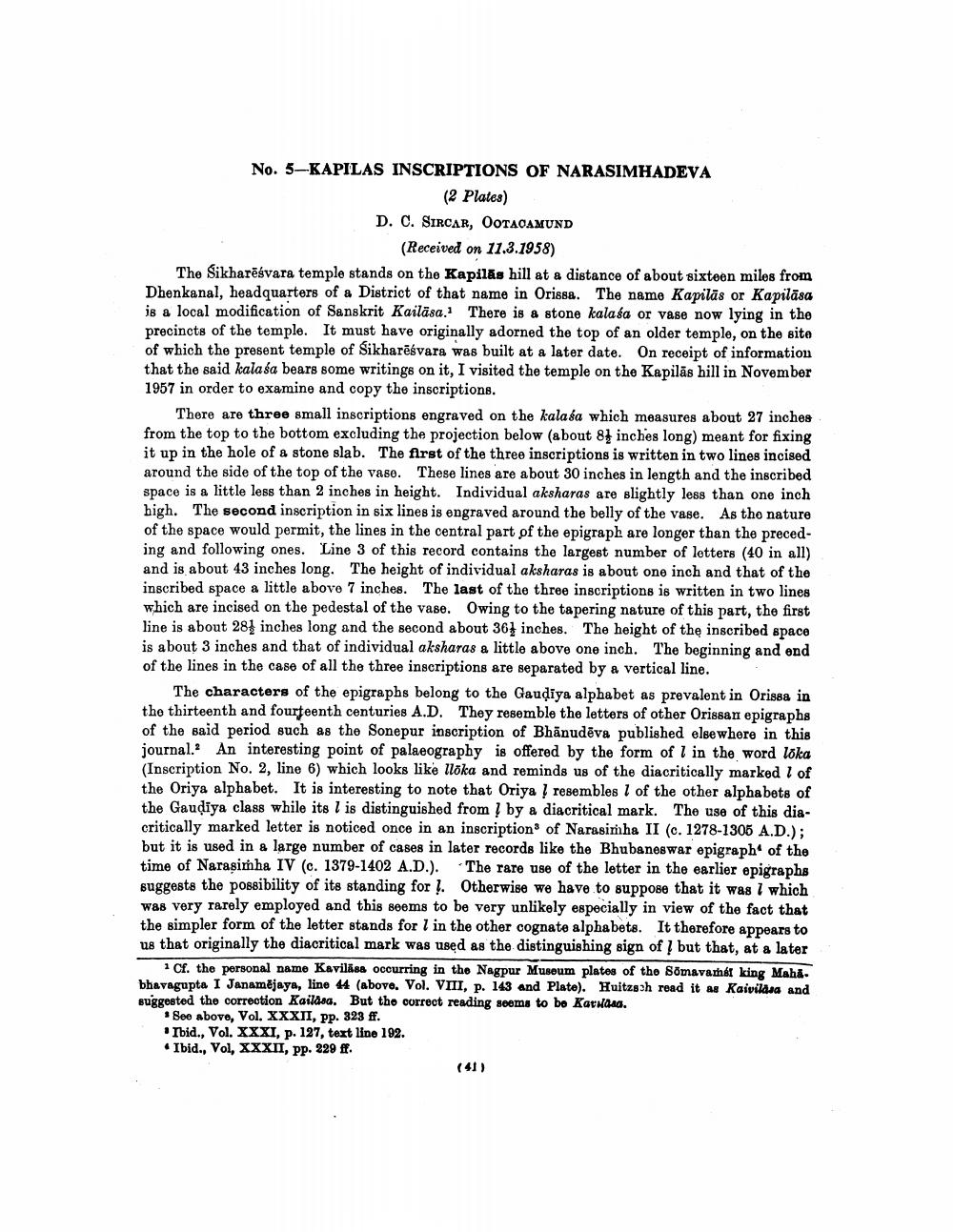________________
No. 5-KAPILAS INSCRIPTIONS OF NARASIMHADEVA
(2 Plates) D. C. SIRCAR, OOTACAMUND
(Received on 11.3.1958) The Sikharēsvara temple stands on the Kapilās hill at a distance of about sixteen miles from Dhenkanal, headquarters of a District of that name in Orissa. The name Kapilās or Kapilāsa is a local modification of Sanskrit Kailāsa. There is a stone kalasa or vase now lying in the precincts of the temple. It must have originally adorned the top of an older temple, on the site of which the present temple of Sikharēsvars was built at a later date. On receipt of information that the said kala sa bears some writings on it, I visited the temple on the Kapilās hill in November 1957 in order to examine and copy the inscriptions.
There are three small inscriptions engraved on the kalasa which measures about 27 inches from the top to the bottom excluding the projection below (about 8 inches long) meant for fixing it up in the hole of & stone slab. The first of the three inscriptions is written in two lines incised around the side of the top of the vaso. These lines are about 30 inches in length and the inscribed space is a little less than 2 inches in height. Individual aksharas are slightly less than one inch high. The second inscription in six lines is engraved around the belly of the vase. As the nature of the space would permit, the lines in the central part of the epigraph are longer than the preceding and following ones. Line 3 of this record contains the largest number of letters (40 in all) and is about 43 inches long. The height of individual aksharas is about one inch and that of the inscribed space a little above 7 inches. The last of the three inscriptions is written in two lines which are incised on the pedestal of the vase. Owing to the tapering nature of this part, the first line is about 281 inches long and the second about 364 inches. The height of the inscribed space is about 3 inches and that of individual aksharas a little above one inch. The beginning and end of the lines in the case of all the three inscriptions are separated by a vertical line. .
The characters of the epigraphs belong to the Gaudiya alphabet as prevalent in Orissa in the thirteenth and fourteenth centuries A.D. They resemble the letters of other Orissan epigraphs of the said period such as the Sonepur inscription of Bhānudēva published elsewhere in this journal. An interesting point of palaeography is offered by the form of l in the word loka (Inscription No. 2, line 6) which looks like Iloka and reminds us of the diacritically marked 1 of the Oriya alphabet. It is interesting to note that Oriya | resembles l of the other alphabets of the Gaudiya class while its l is distinguished from ļ by a diacritical mark. The use of this diacritically marked letter is noticed once in an inscription of Narasimha II (c. 1278-1305 A.D.); but it is used in a large number of cases in later records like the Bhubaneswar epigraph of the time of Narasimha IV (c. 1379-1402 A.D.). The rare use of the letter in the earlier epigraphs suggests the possibility of its standing for l. Otherwise we have to suppose that it was 1 which was very rarely employed and this seems to be very unlikely especially in view of the fact that the simpler form of the letter stands for l in the other cognate alphabets. It therefore appears to us that originally the diacritical mark was used as the distinguishing sign of ? but that, at a later
Cf. the personal name Kaviläsa occurring in the Nagpur Museum plates of the Somavamót king Mahi. bbayagupta I Janamejaya, line 44 (abovo. Vol. VIII, p. 143 and Plate). Huitzsah read it as Kaivildea and suggested the correction Kailasa. But the correct reading seems to bo Karnata.
* See above, Vol. XXXII, pp. 323 ff. . Ibid., Vol. XXXI, p. 127, text line 192. • Ibid., Vol. XXXII, pp. 229 ff.




